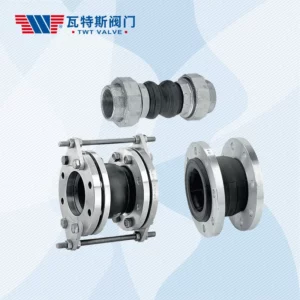Posted on March 7, 2023
What are the different types of rubber expansion joints?
There are several types of rubber expansion joints, including:
- Single sphere rubber expansion joint
- Double sphere rubber expansion joint
- Elbow type rubber expansion joint
- Taper rubber expansion joint
There are several types of rubber expansion joints available, including:
- Single Sphere Rubber Expansion Joint: This is the most common type of rubber expansion joint, consisting of a single rubber sphere with flanges or threaded ends. It is designed to absorb axial, lateral, and angular movements in piping systems.
- Double Sphere Rubber Expansion Joint: Similar to the single sphere joint, this type of expansion joint consists of two rubber spheres connected by a sleeve. It is better suited for systems with high axial movement and vibration.
- Elbow Type Rubber Expansion Joint: This type of expansion joint is designed to absorb angular movements in piping systems. China Rubber Expansion Joint supplier It consists of a curved rubber body with flanges or threaded ends, allowing it to absorb both lateral and angular movements.
- Taper Rubber Expansion Joint: This type of expansion joint is used in applications where the diameter of the piping changes. It consists of two rubber cones connected by a sleeve, allowing it to absorb axial and angular movements while accommodating the change in diameter.
What factors should be considered when selecting a rubber expansion joint?
Several factors should be considered when selecting a rubber expansion joint, including:
- The type of fluid or gas being conveyed: Certain chemicals and substances can react with the rubber material, which can cause the expansion joint to degrade or fail over time. It is important to ensure that the rubber material is compatible with the fluid or gas being conveyed.
- The temperature and pressure of the system: Rubber expansion joints are designed to operate within certain temperature and pressure ranges. It is important to ensure that the selected expansion joint can handle the temperature and pressure of the system.
- The amount and direction of movement expected: Different types of expansion joints are designed to absorb different types and amounts of movement, including axial, lateral, and angular movements. It is important to select an expansion joint that can accommodate the expected movement in the piping system.
- The size and length of the joint needed: The size and length of the expansion joint needed will depend on the size and layout of the piping system. It is important to select an expansion joint that can fit within the available space and accommodate the expected movement.
- The installation and maintenance requirements: Different types of expansion joints may have different installation and maintenance requirements. It is important to select an expansion joint that can be installed and maintained easily, and that is compatible with the available space and equipment.


